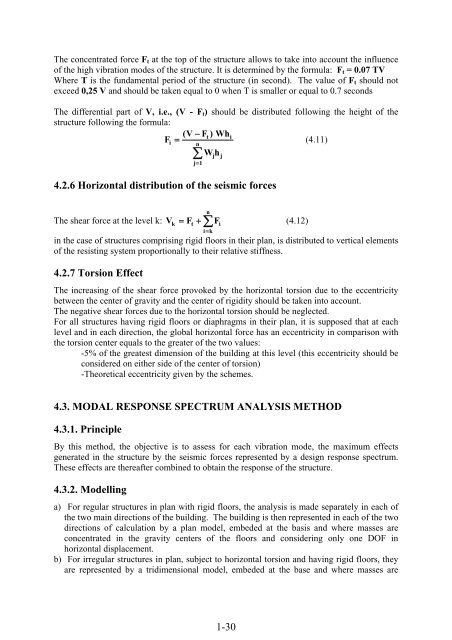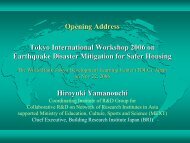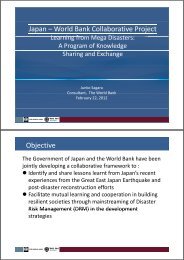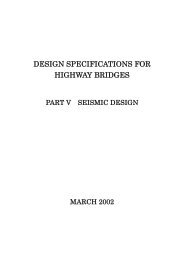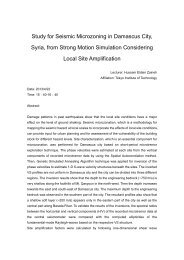algerian earthquake resistant regulations « rpa 99 - IISEE
algerian earthquake resistant regulations « rpa 99 - IISEE
algerian earthquake resistant regulations « rpa 99 - IISEE
You also want an ePaper? Increase the reach of your titles
YUMPU automatically turns print PDFs into web optimized ePapers that Google loves.
The concentrated force F t at the top of the structure allows to take into account the influence<br />
of the high vibration modes of the structure. It is determined by the formula: F t = 0.07 TV<br />
Where T is the fundamental period of the structure (in second). The value of F t should not<br />
exceed 0,25 V and should be taken equal to 0 when T is smaller or equal to 0.7 seconds<br />
The differential part of V, i.e., (V - F t ) should be distributed following the height of the<br />
structure following the formula:<br />
(V − F t ) Whi<br />
Fi<br />
= (4.11)<br />
n<br />
W h<br />
∑<br />
j=<br />
1<br />
4.2.6 Horizontal distribution of the seismic forces<br />
j<br />
j<br />
The shear force at the level k: V = F + F<br />
(4.12)<br />
k<br />
t<br />
n<br />
∑<br />
i=<br />
k<br />
i<br />
in the case of structures comprising rigid floors in their plan, is distributed to vertical elements<br />
of the resisting system proportionally to their relative stiffness.<br />
4.2.7 Torsion Effect<br />
The increasing of the shear force provoked by the horizontal torsion due to the eccentricity<br />
between the center of gravity and the center of rigidity should be taken into account.<br />
The negative shear forces due to the horizontal torsion should be neglected.<br />
For all structures having rigid floors or diaphragms in their plan, it is supposed that at each<br />
level and in each direction, the global horizontal force has an eccentricity in comparison with<br />
the torsion center equals to the greater of the two values:<br />
-5% of the greatest dimension of the building at this level (this eccentricity should be<br />
considered on either side of the center of torsion)<br />
-Theoretical eccentricity given by the schemes.<br />
4.3. MODAL RESPONSE SPECTRUM ANALYSIS METHOD<br />
4.3.1. Principle<br />
By this method, the objective is to assess for each vibration mode, the maximum effects<br />
generated in the structure by the seismic forces represented by a design response spectrum.<br />
These effects are thereafter combined to obtain the response of the structure.<br />
4.3.2. Modelling<br />
a) For regular structures in plan with rigid floors, the analysis is made separately in each of<br />
the two main directions of the building. The building is then represented in each of the two<br />
directions of calculation by a plan model, embeded at the basis and where masses are<br />
concentrated in the gravity centers of the floors and considering only one DOF in<br />
horizontal displacement.<br />
b) For irregular structures in plan, subject to horizontal torsion and having rigid floors, they<br />
are represented by a tridimensional model, embeded at the base and where masses are<br />
1-30


